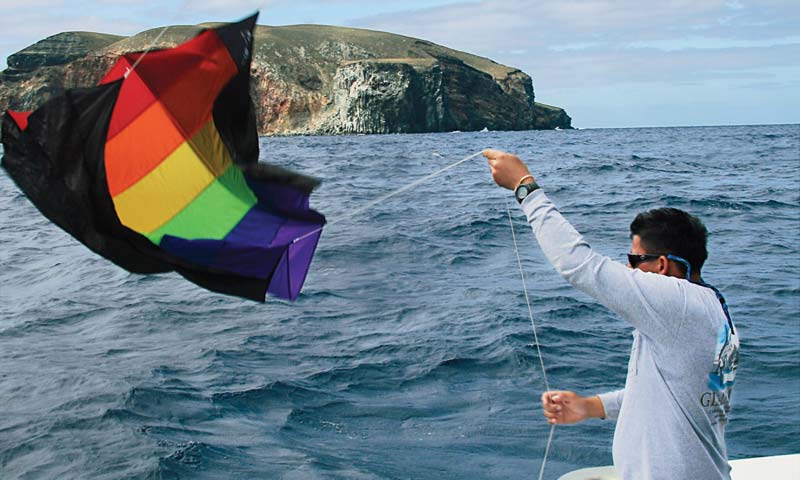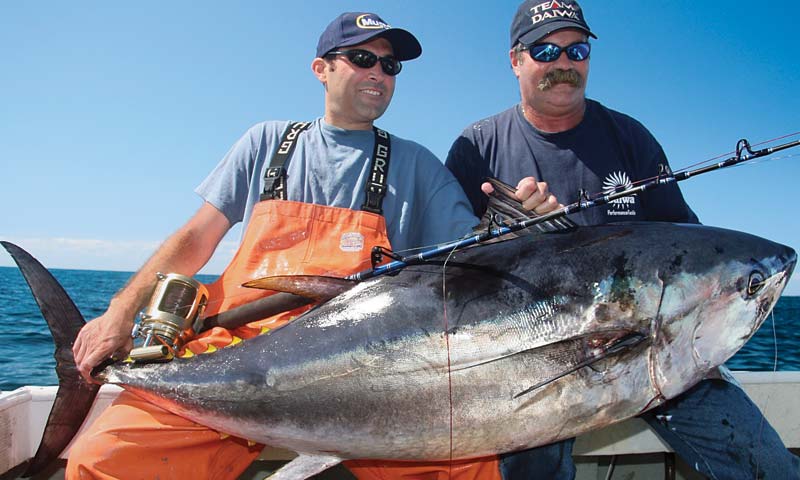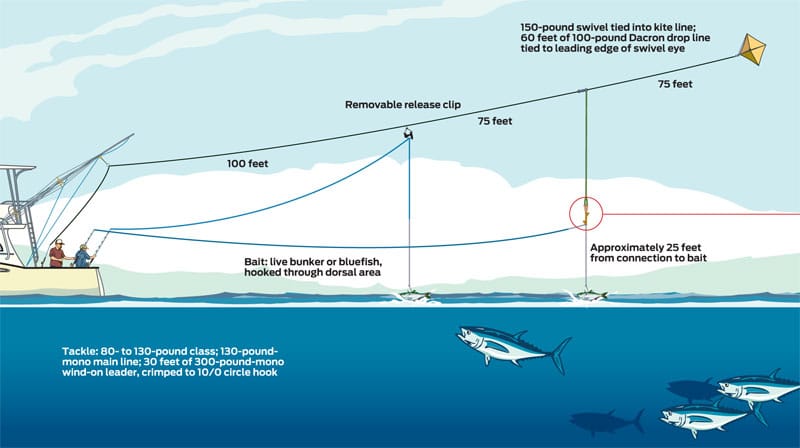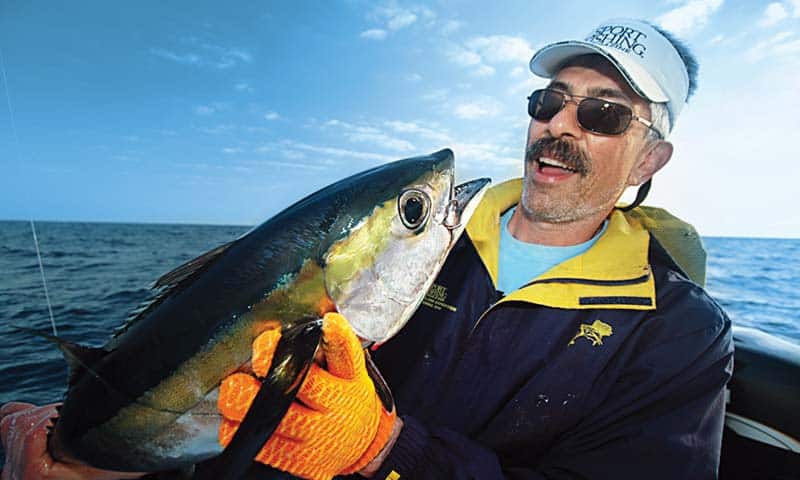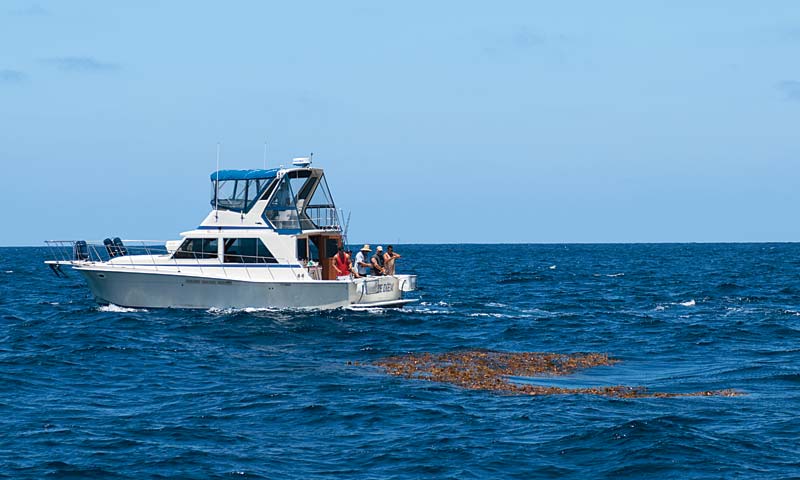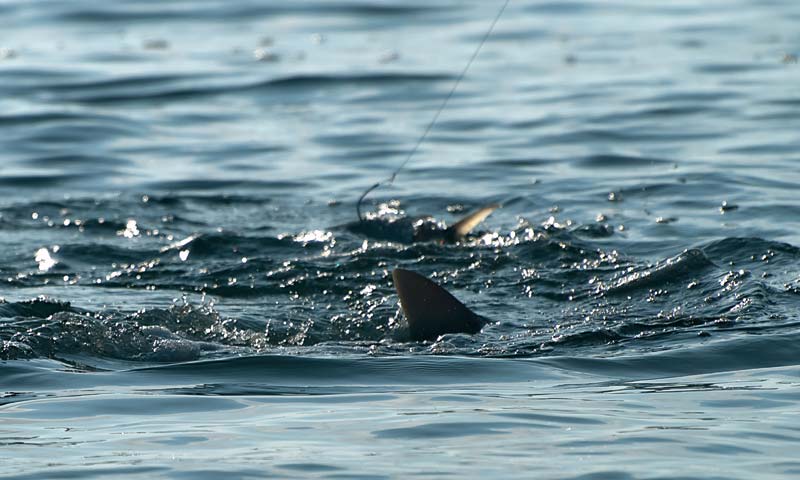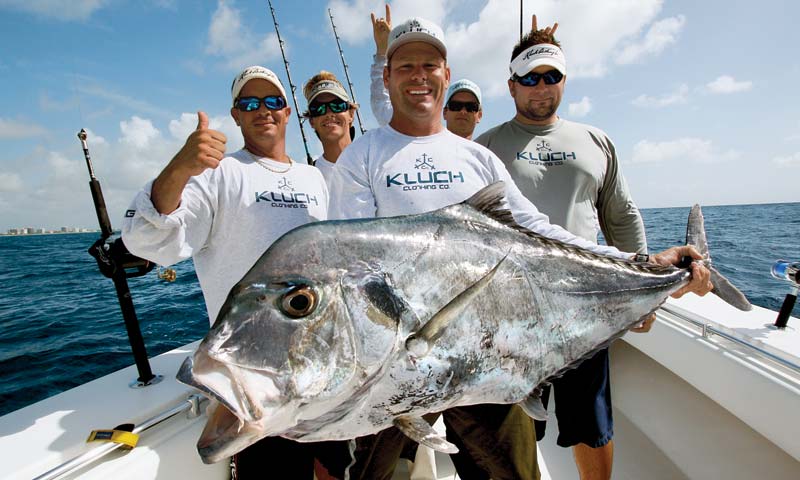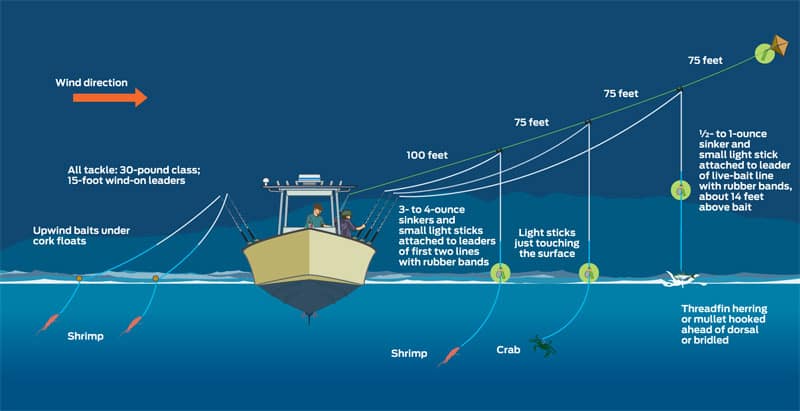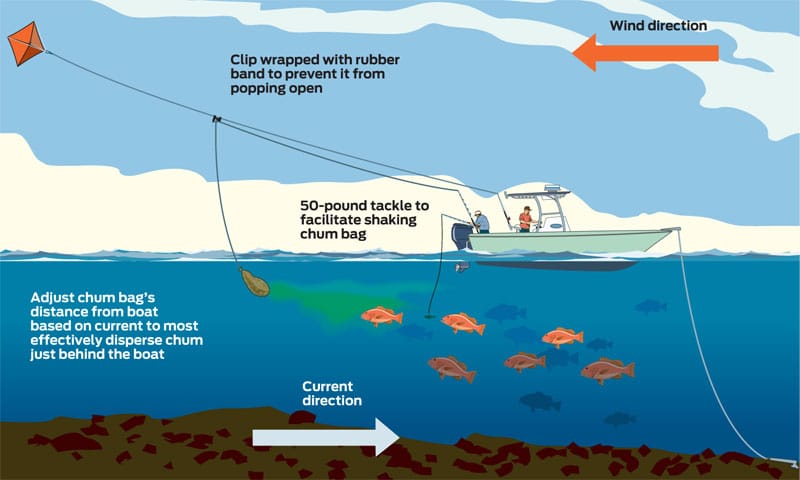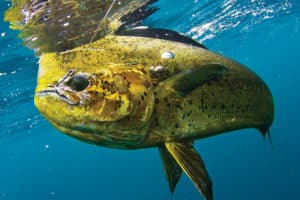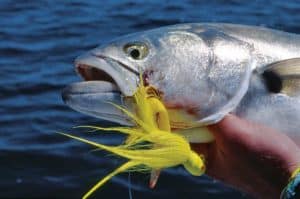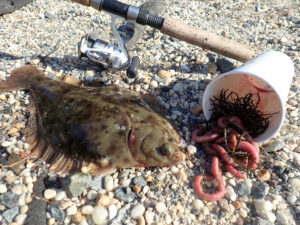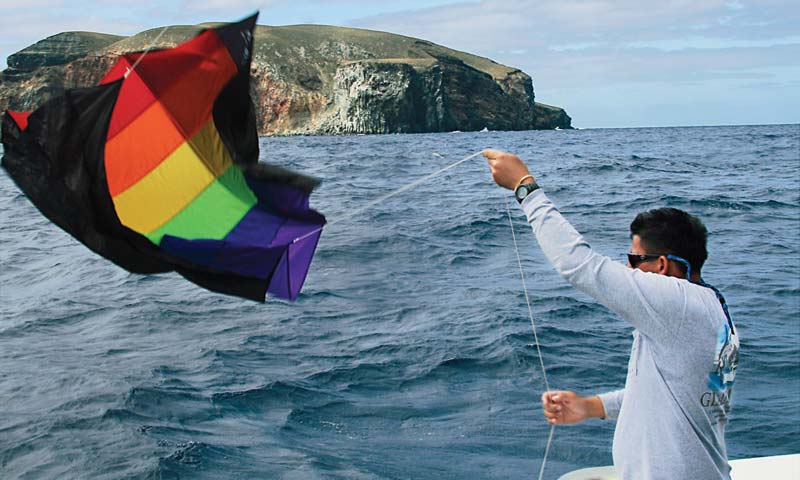
Cabo Kite Fishing
On any cool winter day off South Florida, brightly colored dots speckle the horizon offshore. If it’s sailfish season, it’s kite time. But kites — no longer limited to the domain of sailfish anglers — now find use for tunas (bluefin, blackfin and yellowfin), swordfish, striped bass, tarpon, redfish, roosterfish and more. Wherever fish snack near the surface, kites bring bites.
Here, pro captains share more than a dozen tricks in fisheries where kites might not be common but can solve specific problems and raise the odds for success — from inshore to blue water, coast to coast — techniques that might have broad applicability for many species in many waters.
Massachusetts Bluefin Tuna
In part, interest in kites has proved so contagious because the bites are mesmerizing. “It doesn’t even look real,” says Capt. Brett Wilson of giant bluefin tuna leaping out of the water after bluefish or bunker dangled just at the water’s surface. “It’s like you’re watching something out of a movie,” he says. “A 1,000-pound fish is coming completely out of the water. You think it’s a freaking submarine.”
Wilson (hindsightsportfishing.com) runs charters out of Miami through the winter and then from Cape Cod over the summer. Last year, he caught 54 bluefin tuna in 10 weeks ranging from 400 to more than 900 pounds while kite-fishing. (Many of those hit the kite baits, and others were lured to the kite baits and then whacked livies fished just below.) Despite the surface fireworks, clearly the kite isn’t just for entertainment. “The baits are up high. I don’t have a bunch of line in the water, so I can use heavier leader,” Wilson says. He puts 300-pound fluorocarbon leaders on kite baits, but 200-pound or less otherwise. “I’ve caught 1,000-pounders on 180-pound leader, but with 300 they’re a lot less likely to chafe off.” He also says that less line in the water with a kite results in cleaner bites with better hookups.
Wilson’s drop-line technique should be of interest for tuna enthusiasts but might also have broad applicability in other fisheries as well. It minimizes slack in the line once a fish pulls a line from a kite clip. The drop line also lightens the load of 130-pound mono the kite has to hold aloft. Instead of using a clip for the long kite bait, Wilson ties about 60 feet of Dacron to a swivel in the kite line. He doubles two #64 rubber bands and attaches them to a loop spliced in the other end of the Dacron. He places another rubber band on his fishing line about 25 feet from his bait, securing the rubber band around the line by passing it once through itself. Those rubber bands are tied together with a simple square knot. “The single rubber band on the fishing line is always the one to break.” Wilson says, thereby avoiding a knot of rubber on his fishing line. If he uses bait smaller than a bluefish, Wilson cuts through one leg of that rubber band to make it break with less tension. He adjusts the height and distance of the kite as well as the placement of the rubber band along the main line so his bait stays right on the surface. Completing his drift spread, Wilson’s short kite bait runs through a Blacks clip as customary for kite-fishing, and he drops a third line in the water with no weight and a balloon attached about 50 feet above the live bait.
California Marlin/Pelagics, Kelp Bass in Close
Understanding what kites do best and why can reveal hidden opportunities to hook fish from the sky. “The drawback to kite-fishing is you lose mobility,” says Joe Neber, president of Contender Boats (www.contenderfishingboats.com). When kite-fishing, “you want to fish structure, something that causes eddies or rips that hold bait, places you’d expect to have pelagic action,” Neber says. In 2007, he and Capt. George Mitchell, both experienced Florida kite-fishermen, went to California for the Contender Avalon Billfish Classic. “The wind was howling,” Neber says. “Guys out there normally sight fish for striped marlin, but on that day, they couldn’t. It was so rough, they couldn’t stand up.” To Florida fishermen, that’s when sailfishing is best. Calling upon those heavy-weather kite skills, the two worked charted seamounts. “The kites gave us the ability to put more baits in the water, six on the kites and two flat lines,” Neber says. “If there are marlin under there, they’re going to come up and eat.” And eat they did. Mitchell’s Contender, Snake Dancer, secured second place in the tournament.
West Coast captain Barry Brightenburg (www.alwaysanadventurecharters.com) stumbled upon kite-fishing in the early 1990s, when East Coast kite-fishing techniques found their way to the long-range boats for yellowfin tuna. “Kite-fishing began here on the West Coast for the big bluefin tuna, but we lost track of it for 100 years.” Brightenburg’s comment refers to records of the Tuna Club in Avalon that show Capt. George Farnsworth catching tuna on kites around the turn of the 20th century.
“Now it’s come full circle,” Brightenburg says. His favorite kite trick is snatching fish from the top of kelp aggregations (“paddies” in Southern California parlance) that break free from the bottom and drift into deep water. “They get a lot of pressure. In the past, if I saw three or four boats on a kelp, I wouldn’t bother going there,” he says. “Now I’ll slow-troll a live bait from a kite, and I can still scratch out a good day.”
For marlin and bluefin or yellowfin tuna, Brightenburg slow-trolls live mackerel, sardine or squid on 7/0 circle hooks within a few hundred feet of the paddy. The kite keeps leaders and hardware above the water, and presents baits farther from the boat where they entice bites from overworked fish. Mahi and yellowtail eat much closer to the kelp. “I can put that bait where I want it,” Brightenburg says of the kite. “Sometimes I’ll skip it right on top of the kelp; the circle hook won’t snag the kelp.” Other angling applications are obvious — boat-shy mahi on debris, sargassum weed lines or kelp paddies, or to make fishing feasible when omnipresent weed constantly fouls trolled baits.
Brightenburg follows the same prescription to catch big kelp (calico) bass close to shore, using kites to drop baits where boats can’t go. “The big calicos live in very shallow water, less than six feet,” Brightenburg says. But jagged rock formations and thick kelp keep him from safely getting within casting range. Dropping a bait from above seems simple enough, but the Brightenburg has a slick secret he reveals: a rig for retrieving hooked fish through a jungle of kelp. He uses 30- to 50-pound Spectra and less than a yard of fluorocarbon tied between the Spectra and a 3/0 to 7/0 circle hook. “A kelp stalk is about the size of your pinky. It fits right into the bend of a J hook, but the design of the circle hook prevents that, and the Spectra cuts right through the stalks,” Brightenburg says. “We wind the bass right through the kelp.” Braid also weighs less on the kite in Pacific zephyrs, and it creates less drag in the water resulting in livelier baits.
Costa Rica Roosterfish
Jeff Schatman grew up fishing kites in Miami, but he’s spent seven years running a 60-foot Bertram in Costa Rica (fishhard785@aol.com). “In places like Negritos, on the tip of the Nicoya Peninsula, the roosterfish lay right up on the rock,” Schatman says. Notorious currents there plus an onshore breeze often keep him outside casting range. “With the kite, I can get a bait right where I want it: against the rocks,” he says.
Even in open water, Schatman often doubles his roosterfish catches from five or six to a dozen or more in a few hours of fishing by using live herring on a kite. “Where I could fish only one bait before, with the kite we fish two lines, one on the kite and a flat line,” he says. “The first day I tried it, as fast as we could get the baits out, we’d hook doubles.” On days he can anchor, Schatman drops a third line deep with a 4- to 8-ounce lead sliding above the leader’s swivel, and he often hooks roosterfish triples. On his best afternoon, Schatman caught 18 roosterfish and three cubera snapper.
Like all pros contributing to this feature, Schatman says kites don’t always outperform traditional methods, but he believes fishing for a species using many different approaches increases his knowledge of those game fish, particularly with kites, where the bite is consistently in view on top.
**
South Carolina Redfish and Tarpon**
A particularly unusual kite technique comes from Charleston, South Carolina, flats guide Jamie Hough (www.flatspotcharters.com). In the waters Hough fishes, bottlenose dolphin routinely stalk redfish in as little as a foot of water, pushing reds into the marsh grass at high tide and keeping them in shallow water at low tide. “I draw 10 inches, but sometimes those fish are in three or four inches of water. If the water covers their lips, that’s all they need,” Hough says. “I saw a bunch of fish laying in there at low tide for a whole week, but I just couldn’t get to them.” Calling on his nine winters as an Islamorada charter-boat mate, Hough set a kite and dropped a finger-mullet head into the shallow water. Success didn’t come at first, though, as the long drop back from the kite resulted in few hookups. “It turned out, I had to make the kite clip as tight as I could,” Hough says. “We let them eat it for a second. When we come tight, we’re setting the hooks. Then, when the line comes out of the clip, they’re already on.”
Hough uses a variety of live or dead baits, and even slowtrolls artificial grubs from the kite with the boat in deeper water, prospecting for fish in poor visibility. “When it’s blowing 30, most people consider that a washout. You’re not going to be poling around looking for fish in water that looks like chocolate milk,” Hough says. “Use that wind. Put the kite up and drive around until you find a school.” Hough also uses kites when kids who can’t sit still spook fish close to the boat. He warns to be aware of sun angles, though, as a kite’s shadow will scatter an entire school of redfish.
Hough uses the kite for tarpon as well, to hook fish otherwise missed because the large, 12- to 15-inch-long mullet often are the smallest available. For better hookups, Hough puts one circle hook just ahead of the mullet’s eyes and attaches a stinger circle hook to the tail with a black rubber band. “I paint the hooks black, but with all that tackle in the water, we don’t get as many bites,” he says. “With the fish on the kite, up on the surface, there’s foam, there’s splashing, there’s wake — there’s more for the tarpon to focus on besides that terminal tackle.”
Hough’s anglers can also use kites to keep baits away from sharks by cranking baits up, out of harm’s way, and he gains the ability to cover more water by positioning a bait off the side of the boat when others are taken astern by current. “You can still cast and do all the other stuff while the kite’s out,” he says. “It’s just one more bait in the water.” There is one more plus: The surface bite of a 200-pound tarpon is spectacular. “It’s unreal. They come out of the water full force, like a skyrocketing kingfish,” he says. “As many times as I’ve seen it, I still freak out a little bit.”
Brett Wilson uses a variation of Hough’s redfish technique in Massachusetts’ Cape Cod Bay when striped bass nearshore lie in water too shallow for his boat. A less-obvious advantage Wilson sees in using a kite: It appeals to a different class of angler. “A lot of people just want to fill their coolers,” Wilson says. For those clients, he’ll use wire line trolled slowly along the bottom or similar standard striped bass techniques. “The kite offers a chance to fish light line, to do something different,” he says. “Kite-fishing for stripers is for the elite angler, the light-tackle enthusiast.” This advantage of kites is likely true for anglers pursuing any species that will bite on the surface.
Florida Tarpon, Swords, Reds and Bones
It seems clear the kite-fishing pandemic originated in South Florida. Most kite pros I’ve spoken with fished professionally at one time or another in that 70-mile stretch from Miami through Islamorada, Florida. Any in-depth look at kite-fishing wouldn’t be complete without considering the unique insight of pros fishing here.
Ray Rosher, one of the top sailfish tournament and charter captains in South Florida (www.missbritt.com), understands and exploits the advantages of kites whenever he sees a sensible opportunity. For example, while drifting for tarpon, Rosher puts out one to three baits on one side of the boat under the kite, depending upon kite-flying conditions, and two more flat lines drifting off the other side. “I noticed we’d get a bite on the long kite bait first, then the short, and then the flat lines,” he says. As he drifts over a body of fish, anglers get more shots at them.
Rosher hangs three different baits from the kite for tarpon. A live threadfin herring goes on the long clip, fished near the surface. A live crab on the middle clip is treated a bit differently: A 3- or 4-ounce lead at the top of the leader is kept very close to the water. “Hook the crab in the side like normal, but you want to tow it through the water sideways,” Rosher says. The shrimp’s sinker similarly stays just above or below the water’s surface. He attaches leads near the top of wind-on leaders with rubber bands and adds a light stick as a kite marker at night. If there isn’t enough wind for the kite to support that much weight, Rosher gives it extra lift with a helium balloon.
When nighttime swordfishing, Rosher drifts with five lines out on the windward side of the boat — typical of South Florida swordfishermen. But he also uses the kite to get an extra line 150 feet or so off the lee side of the boat. With a rubber band, he attaches a 3-ounce lead and light stick about halfway down a 30-foot wind-on leader. “Keep that light right around the surface. Above or below the water doesn’t really seem to matter. When you get a bite, that light stick goes streaming across the surface. Reel to bring in the kite as fast as you can,” he says; otherwise, the tight kite clip might drag the kite into the water.
Bouncer Smith, another well-known Miami charter skipper (www.captbouncer.com), often fishes along Miami-Dade County beaches that are buoyed to prevent boats from traveling where bathers swim. When beaches aren’t crowded, Smith says, “we’ll use the kite to get live baits to tarpon and snook that follow the bait schools in to where we’re not allowed to go with the boat.”
Similarly, he uses kites to reach bonefish and redfish on flats in Biscayne Bay, where water is too shallow for his 33-foot open fisherman. “We can see them from the finger channels but can’t cast to them,” he says. “I’ll put a bag of cut-up shrimp on one clip and a live shrimp or pilchard on the other,” he says. “I use a split shot on the kite line to hold one kite clip so the live bait is only about five feet from the chum bag.”
Keys Bull Sharks, Yellowtail and More
Farther south, in the Florida Keys, Capt. Jim Dalrymple (jamesdalrymple@bellsouth.net), based in Tavernier, takes the opposite approach for inshore bull sharks and blacktips. He anchors his bay boat in shallow water with a Power Pole and uses the kite to suspend baits in the fast-moving water of deep channels that cuts through the banks where sharks travel.
Dalrymple also flies kites for tarpon, primarily in the spring, when he uses mullet for bait. “I’ll put the reel in gear and just let the tarpon pull the bait out of the clip. With that drop-back, they hook themselves,” he says. Dalrymple cautions that his hookup ratios are lower when he switches to crab as his preferred bait, in the summer. “The drop-back on the kite kills you with crabs. They eat the crab, crush it and blow out the top of the shell in one motion, and spit your hook along with it,” he says. But even late in the season, when he prefers crabs, Dalrymple often flies the kite for tarpon using mullet just to enjoy the spectacular surface bites.
Some Islamorada fishermen have found interesting and surprising uses for kites. For example, “when we’re bottomfishing, there’s always a kite up,” says Augie Wampler, charter captain in Islamorada (www.bluewaterpredator.com). “We’re not targeting a species, we’re targeting the edge of the reef. Kingfish, cobia, African pompano — I don’t care what swims by: If it sees a threadfin herring or a sardine, it just can’t help but eat it.” Wampler even uses two kites to fish multiple depths at once, increasing his chances for a wide variety of hookups on any given day.
Interesting kite catches include reef-dwelling yellowtail. In the Florida Keys, yellowtail can often be chummed to the surface from just over wrecks and reefs 80 or 100 feet below, particularly during spring spawning. If the yellowtail are running on the small side, “throw some live pilchards out, and pretty soon you’ll see the big ones busting right on the surface,” Wampler says. Then, use kites to keep live baits right on top where the big, 5-pound flag ‘tails eat.
**
Southeast Kingfish**
Kingfish bites on the kite are considered a nuisance for those targeting sailfish in South Florida — a fact not lost on Capt. Jamie Ralph, who runs charters from Boynton Beach, Florida (thinkblue42@hotmail.com). Ralph fishes both kingfish and sailfish tournaments. His 2010 SKA Yamaha Pro Championship Angler of the Year title came when Steve Glanz, owner of the 36-foot Invincible Skin Deep, passed the trophy to Ralph for his truly slick kite work as the boat’s captain. Ralph says the tricks he used should work in much of the Southeast. “The fish were eating bluefish right on the beach in 10 feet of water,” Ralph says, but a stiff onshore breeze and breaking surf kept him out in 17 feet or deeper. “We put up three kites with one large bait on each kite. As the kingfish bounced back and forth along the beach, having three kites helped us stay right on the pod of fish,” he says. Ralph’s expertise helped him steer two kites far apart with leads in the top corners so he could slide the third kite between.
“The kites caught about two-thirds of our fish in that tournament,” he says. Yet during many tournaments, Skin Deep’s kites don’t leave their storage tubes. “It’s just another tool,” Ralph says. “Kites help us out when we need them.” Another of Ralph’s favorite kite tricks: “In the springtime we get the big flying fish showering,” Ralph says. “I’ll put out a tiny goggle eye, the smallest I can get, on the kite. It’s a great way to mimic those flyers.”
Of all these kite experts, Wampler probably hit best upon why flying a kite seems to get into fishermen’s blood. “It’s fun. You feel like you’re fishing instead of sitting in the chair watching four ballyhoo behind the boat,” he says. Kite-fishermen continue to break boundaries in terms of new applications, target species and areas. One might say more and more anglers are rethinking the old maxim that the sky’s the limit.
